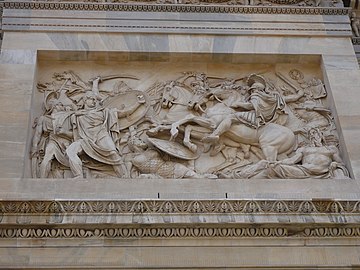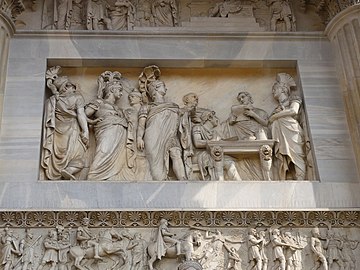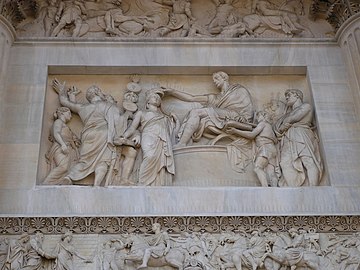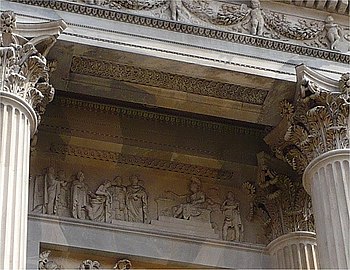Porta Sempione
Porta Sempione | |
|---|---|
City Gate | |
UTC+2 (CEST ) |

Porta Sempione ("Simplon Gate") is a city gate of Milan, Italy. The name is used both to refer to the gate proper and to the surrounding district (quartiere), a part of the Zone 1 division (the historic city centre), including the major avenue of Corso Sempione.[a] The gate is marked by a landmark triumphal arch called Arco della Pace ("Arch of Peace"), dating back to the 19th century, although its origins can be traced back to a gate of the Roman walls of Milan.
The gate
History

A gate that roughly corresponds to modern Porta Sempione was already part of
In the Middle Ages, part of the Roman walls in the Porta Sempione area was adapted as part of
In 1807, under the
The construction of the Arch was resumed, again by Cagnola, in 1826, for Emperor Francis II, who dedicated the monument to the 1815 Congress of Vienna. When Cagnola died in 1833, his project was taken over by Francesco Londonio and Francesco Peverelli, who brought it to completion in 1838.
The gate was the scene of several prominent events in the Milanese history of the 19th century. On 22 March 1848, the
Site and decoration

The gate is located at the center of a wide round square known as Piazza Sempione ("Simplon Square"). It is adjacent to
It is
At the sides of the Arch of Peace there are two minor rectangular buildings that used to be the customs office.
Bas-reliefs of the Arch
-
Congress of Prague, internal bas-relief
-
internal bas-relief
-
bas-relief
-
bas-relief
-
bas-relief
-
Foundation of the Kingdom of Lombardy-Venetia, by Pompeo Marchesi, on the right of the Arch of Peace
-
Institution of the Iron Crown by Giovanni Battista Perabò
References in popular culture
In his novella A Moveable Feast, Ernest Hemingway mentions the Arch of Peace, expressing the belief that its orientation be parallel to those of the Arc de Triomphe du Carrousel and the Arc de Triomphe de l'Étoile in Paris.
The district

The area surrounding Porta Sempione is a prominent historic district of Milan. The district also includes part of Corso Sempione, a large avenue leading to Porta Sempione from the northwest. Some of the most important streets in the area are Via Canonica, Via
. Via Melzi d'Eril and Via Antonio Canova form a half circle concentric to Piazza Sempione.The main landmark of the area is the
The whole area is one of the centres of the Milanese night life, with a number of bars, pubs, restaurants, and discos; since the
Notes
- ^ Note that, since Sempione is also the name of the long avenue leading up to the gate, other areas of Milan are sometimes referred to with names including the word Sempione, yet they are not necessarily in the surroundings of Porta Sempione; for example, the district around the Garegnano Charterhouse is sometimes referred to as Certosa/Sempione.
References
Sources
- Gardiner, Marguerite (Comtesse de Blessington) (1841). The Idler in Italy. Baudry's European Library. pp. 150–151.







